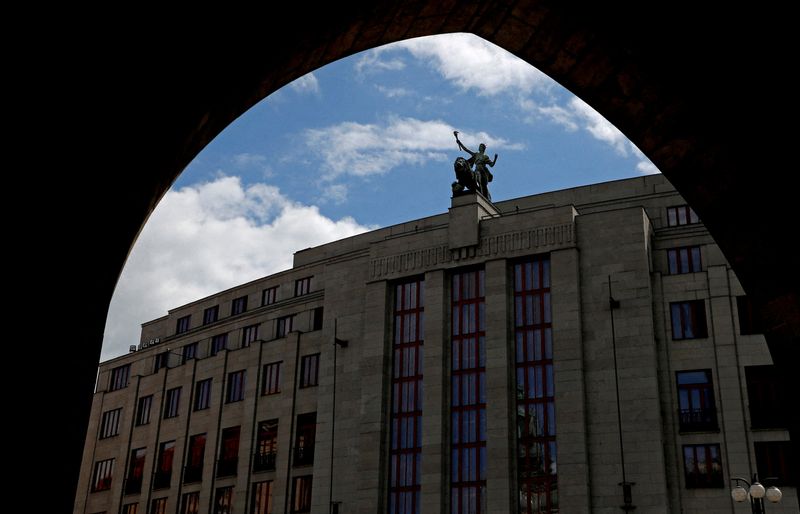
© Reuters. SUBMIT IMAGE: The Czech National Bank is seen in Prague, Czech Republic, April 26, 2023. REUTERS/David W Cerny// File Image
2/2
By Jan Lopatka, Pawel Florkiewicz and Gergely Szakacs
PRAGUE (Reuters) – The Czech National Bank’s “less rush, more speed” rate cut technique appears to be settling with main Europe’s clearest course to low inflation, simply as upside threats loom afresh in neighbours Hungary and Poland.
While its Polish and Hungarian equivalents slashed loaning expenses by numerous basis points in 2015 as inflation pulled away from double-digits, the Czech reserve bank waited till December for its very first decrease, of simply 25 bps.
It acted on Thursday with a 50 bps cut, its biggest in almost 4 years, taking its primary rate to 6.25%. Experts now see the rate decreasing to 4% by the end of the year, the most affordable in the area according to their projections.
With beneficial base impacts set to fade, strong wage walkings in Poland and Hungary might on the other hand enhance underlying cost pressures by sustaining a consumer-driven healing.
Possible cuts in family energy aids in Poland and Hungary in the 2nd half, after European Parliament elections, represent additional threats to the outlook, with inflation seen at in between 5% and 6% in both nations at the end of 2024.
Czech inflation, which the federal government’s tight financial position likewise assists curb, is seen listed below 3% at the end of 2024, near the CNB’s target, offering it space to cut loaning expenses. That might be an advantage for the drooping economy.
” Domestic and external need stay weak,” CNB Guv Ales Michl informed an interview on Thursday.
” The rate of any additional decrease in rates will depend generally on … the determination of the disinflationary pattern, the result of financial policy on the economy, … the labour market circumstance, and the development of domestic and external need.”
A senior IMF authorities stated the CNB needs to nonetheless bear in mind threats to inflation expectations, which stay above its policy target, in addition to possible upside pressure from strong wage development or a more powerful repricing of products and services.
” In the lack of sharp disadvantage surprises in inflation, personnel recommends to preserve a tight financial policy position to combine the disinflation procedure and offer insurance coverage versus a pricey de-anchoring of inflation expectations through early 2024,” Geoff Gottlieb, IMF Senior Citizen Regional Agent for Central, Eastern and South-Eastern Europe, informed Reuters.
” Afterwards, the small policy rate of interest might be decreased carefully and slowly, constant with the anticipated decrease in inflation, with a speed that might be sped up if inflation expectations line up faster to the target than imagined.”
PROLONGED TIME OUT?
A Feb. 5 tally by JP Morgan revealed financiers had actually priced in the CNB almost halving its primary rate to 3.6% over the next 9 months. Hungary’s base rate was seen being up to 5.25%, followed by Poland at 5%, where the tiniest quantity of cuts is priced in.
Leaving its primary rate of interest on hold at 5.75% on Wednesday, the Polish reserve bank flagged numerous upside threats in spite of a decrease in inflation in the very first quarter.
Financial experts surveyed by Reuters see Poland’s primary rate being up to 5.25% by the end of the year, though some anticipate no modification after cuts in 2023 amounting to 100 bps, with Polish inflation still forecasted at a typical 5.6% in the 4th quarter.
National Bank of Poland Guv Adam Glapinski seems occurring to that view.
” In my viewpoint, there will not be such a bulk (for a rate cut) by the end of this year, unless unforeseen situations occur,” Glapinski informed an interview on Thursday, sending out the zloty 0.8% more powerful on the day.
The Polish Financing Ministry stated its choice whether to extend energy aids would depend upon inflation advancements and the general public financial resources, including that it was most likely to decrease its 2024 inflation projection from 6.6% forecasted in the budget plan.
Hungary’s reserve bank has stated it prepares to cut its base rate to 6% -7% by the middle of the year, though falls in the forint in the middle of clashes with the European Union hindered its strategy to briefly speed up the rate of rate cuts.
Financial experts see Hungary’s base rate at 6% at the end of 2024, while inflation is seen rebounding to 5.3% by December from 4.4% anticipated in January.
Must the bank prosper in decreasing the rate to 6% by mid-year, much deeper cuts in the middle of a predicted rebound in inflation might overthrow its technique of keeping rates of interest above the level of cost development.
” General, we anticipate year-end inflation to go beyond 6.5% if energy and energy costs are raised later on this year. This contrasts with a 6% policy rate, which might indicate that (a minimum of briefly due to base impacts) the genuine rate of interest might turn unfavorable once again,” UniCredit economic expert Zsolt Becsey stated.
.